Puerto Rican cuisine is renowned for its vibrant flavors and unique culinary traditions. From traditional dishes like mofongo and arroz con gandules to popular favorites like tostones and pasteles, Puerto Rican side dishes offer a burst of island flavor that is sure to delight your taste buds. Whether you’re looking for easy recipes or authentic dishes, this guide will help you navigate the world of Puerto Rican side dishes and discover the best flavors of the island.
Key Takeaways:
- Discover the vibrant flavors and unique culinary traditions of Puerto Rican side dishes.
- Explore traditional dishes like mofongo, arroz con gandules, and tostones.
- Try popular favorites like pasteles, bacalaitos, and arroz y habichuelas.
- Experience the delicious desserts and drinks of Puerto Rico, such as tembleque and coquito.
- Learn about the cultural significance of these dishes and their role in Puerto Rican cuisine.
Mofongo: Puerto Rican Comfort Food at Its Finest
Mofongo is a beloved Puerto Rican dish that embodies the island’s rich culinary heritage. Made from green plantains, mofongo is a savory and satisfying comfort food that is enjoyed by locals and visitors alike. The dish starts with green plantain pieces that are deep-fried to perfection. The fried plantains are then mashed with garlic and seasoned with salt-cured pork, pork crackling, butter, or oil.
The result is a flavorful mixture that is shaped into a ball or mound. Mofongo can be served as a side dish, accompanying a variety of main courses, or as a standalone dish, stuffed with meats such as shrimp, chicken, or pork, or even vegetables. The combination of the crispy exterior and the creamy interior creates a delightful texture that is both comforting and indulgent.
What sets mofongo apart is its authenticity. This iconic Puerto Rican dish has deep roots in the island’s culinary traditions and is considered a staple in Puerto Rican cuisine. Its savory flavors and unique preparation method make it a must-try dish for anyone looking to experience the true taste of Puerto Rico.
Whether you enjoy it at a local restaurant or try making it at home, mofongo is a delicious introduction to Puerto Rican cuisine. Its simplicity and versatility make it a favorite among locals and visitors alike, and the authentic flavors of the dish are sure to transport you to the beautiful island of Puerto Rico.
Tostones and Amarillos: Traditional Puerto Rican Plantain Dishes
When it comes to Puerto Rican cuisine, plantains are a staple ingredient that takes center stage in many traditional dishes. Two popular Puerto Rican side dishes that showcase the versatility of plantains are tostones and amarillos.
Tostones are savory fried plantains made from green plantains. The plantains are sliced, marinated in water and garlic, fried until golden brown, then smashed and fried again until crispy. The result is a delightful combination of soft interiors and crispy exteriors that make tostones a perfect companion to any main course.
Amarillos, on the other hand, are ripe plantains that are fried until soft and sweet. The natural sugars in the plantains caramelize during the frying process, creating a rich and indulgent flavor. Amarillos are often served alongside savory dishes to provide a contrast in taste and texture.
The Art of Making Tostones
- Start by peeling and slicing the green plantains into 1-inch thick rounds.
- Place the plantain slices in a bowl of water with crushed garlic cloves and let them soak for about 15 minutes.
- Drain the plantain slices and pat them dry with a paper towel.
- In a deep frying pan, heat vegetable oil over medium-high heat.
- Carefully add the plantain slices to the hot oil and fry them until they turn golden brown, about 2-3 minutes per side.
- Remove the plantain slices from the oil and place them on a paper towel-lined plate to drain excess oil.
- Using a tostonera or a flat-bottomed glass, flatten each fried plantain slice to about half its original thickness.
- Return the flattened plantain slices to the hot oil and fry them again until they are crispy and golden brown, about 1-2 minutes per side.
- Remove the tostones from the oil and drain them on a paper towel.
- Serve the tostones immediately with a sprinkle of salt and enjoy!
Preparing Perfect Amarillos
- Choose ripe plantains with yellow skins that have some black spots.
- Peel the plantains by making a lengthwise incision along the ridges and gently pulling the skin away.
- Slice the plantains diagonally into 1-inch thick pieces.
- In a deep frying pan, heat vegetable oil over medium-high heat.
- Add the plantain slices to the hot oil and fry them until they turn golden brown on both sides, about 2-3 minutes per side.
- Remove the amarillos from the oil and place them on a paper towel-lined plate to drain excess oil.
- Allow them to cool slightly before serving.
Whether you prefer the savory crunch of tostones or the sweet tenderness of amarillos, both of these traditional Puerto Rican plantain dishes are sure to delight your taste buds and add a touch of island flavor to your meals.
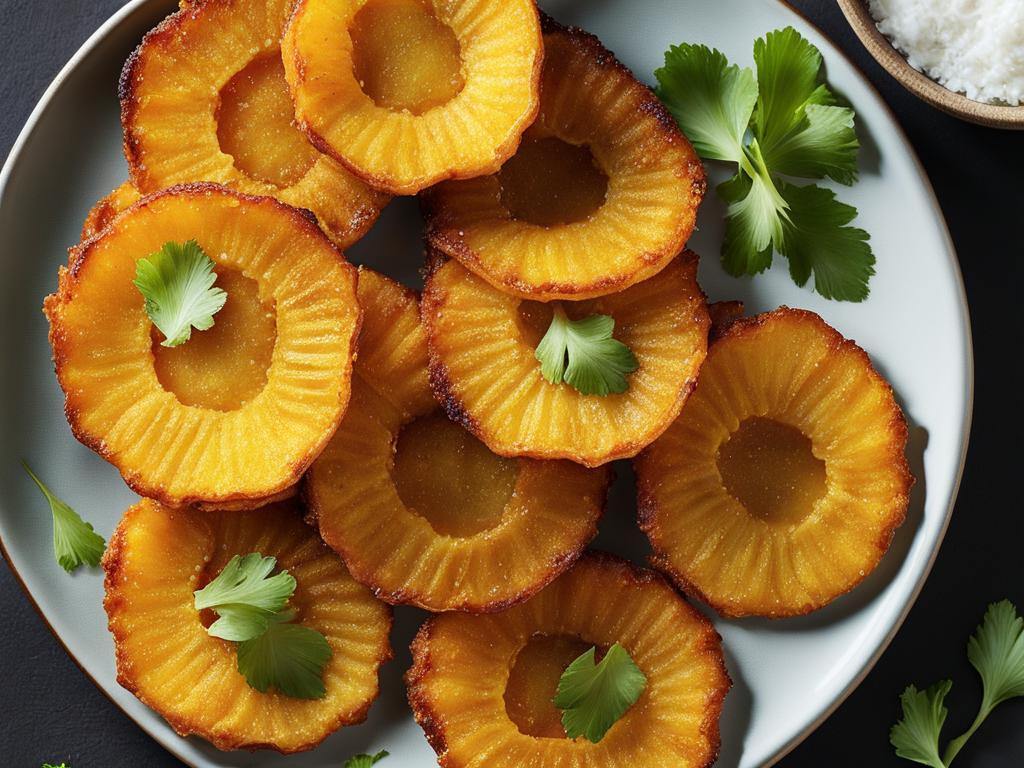
Lechón Asado: A Puerto Rican Culinary Legacy
Lechón asado is a beloved Puerto Rican dish that has become a culinary legacy of the island. This traditional roast, typically made from a whole pig, is a staple at festive occasions and special events. The process of preparing lechón asado involves marinating the pig in adobo, a flavorful mixture of garlic, oregano, black pepper, vinegar, and water, and slow-roasting it over coals until the meat is juicy and the skin is crispy.
The result is a succulent and tender pork shoulder that is bursting with authentic Puerto Rican flavors. The combination of the savory adobo marinade and the slow-cooked meat creates a deliciously rich and smoky taste that is sure to satisfy your taste buds. Whether served as the main course or as a centerpiece at a traditional Puerto Rican feast, lechón asado is a true culinary masterpiece.
To complement lechón asado, another popular pork dish in Puerto Rican cuisine is pernil. Similar to lechón asado, pernil is seasoned with adobo and roasted in the oven. The slow cooking process allows the flavors to meld together, resulting in a tender and flavorful pork shoulder that is often served alongside rice and beans, tostones, or other traditional side dishes. Pernil is a favorite among Puerto Ricans and is enjoyed year-round.
The Flavors of Puerto Rico in Every Bite
Lechón asado and pernil showcase the authentic flavors of Puerto Rican cuisine and provide a taste of the island’s rich culinary heritage. The combination of flavorful seasonings and slow cooking methods results in tender and juicy pork dishes that are deeply infused with traditional Puerto Rican flavors.
Whether you’re exploring Puerto Rican cuisine at a local restaurant or trying your hand at cooking these dishes in your own kitchen, lechón asado and pernil are sure to transport you to the vibrant and flavorful world of Puerto Rico.
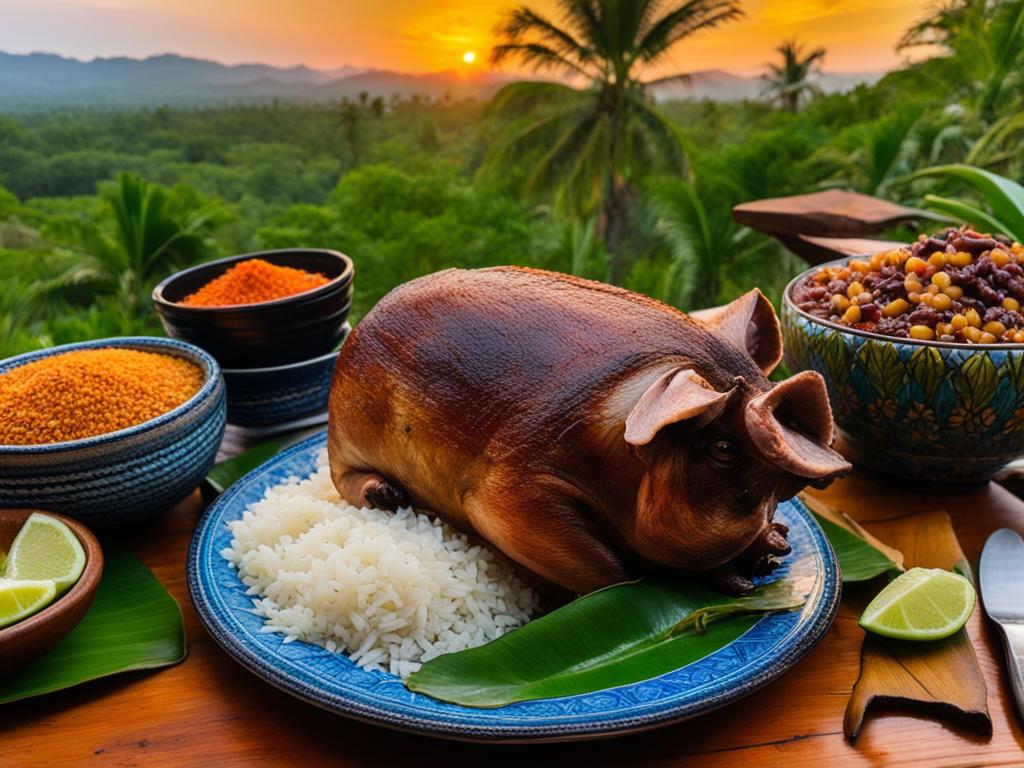
Table: Comparison between Lechón Asado and Pernil
| Aspect | Lechón Asado | Pernil |
|---|---|---|
| Preparation | Marinated in adobo and slow-roasted over coals | Seasoned with adobo and roasted in the oven |
| Cooking Method | Slow-cooked over coals | Oven-roasted |
| Flavor | Savory and smoky | Rich and flavorful |
| Serving | Main course or centerpiece at special events | Accompaniment to rice and beans or other side dishes |
Arroz y Habichuelas: The Quintessential Puerto Rican Side Dish
Arroz y habichuelas, or rice and beans, is the staple side dish in Puerto Rico. This classic combination of flavors is a beloved and versatile dish that is enjoyed by locals and visitors alike. The dish consists of stewed pink beans cooked with onions, peppers, garlic, ham hock, calabaza squash, and the star ingredient, sofrito. Sofrito is a traditional cooking base made from a blend of onion, garlic, peppers, culantro, cilantro, and other herbs and spices that adds depth and richness to the dish.
To prepare arroz y habichuelas, the rice is cooked separately and then served alongside the beans. The beans and sofrito are simmered until they develop a thick and flavorful sauce, and the rice is fluffy and perfectly cooked. The combination of the aromatic sofrito, tender beans, and fluffy rice creates a harmonious blend of flavors and textures that is both comforting and satisfying.
Arroz y habichuelas can be customized to suit various preferences and dietary needs. It can be served as a vegan or vegetarian dish by omitting the meat components and using vegetable broth instead. Additionally, it pairs well with a variety of main courses, such as roasted meats, grilled fish, or roasted vegetables, making it a versatile side dish that complements a wide range of flavors.
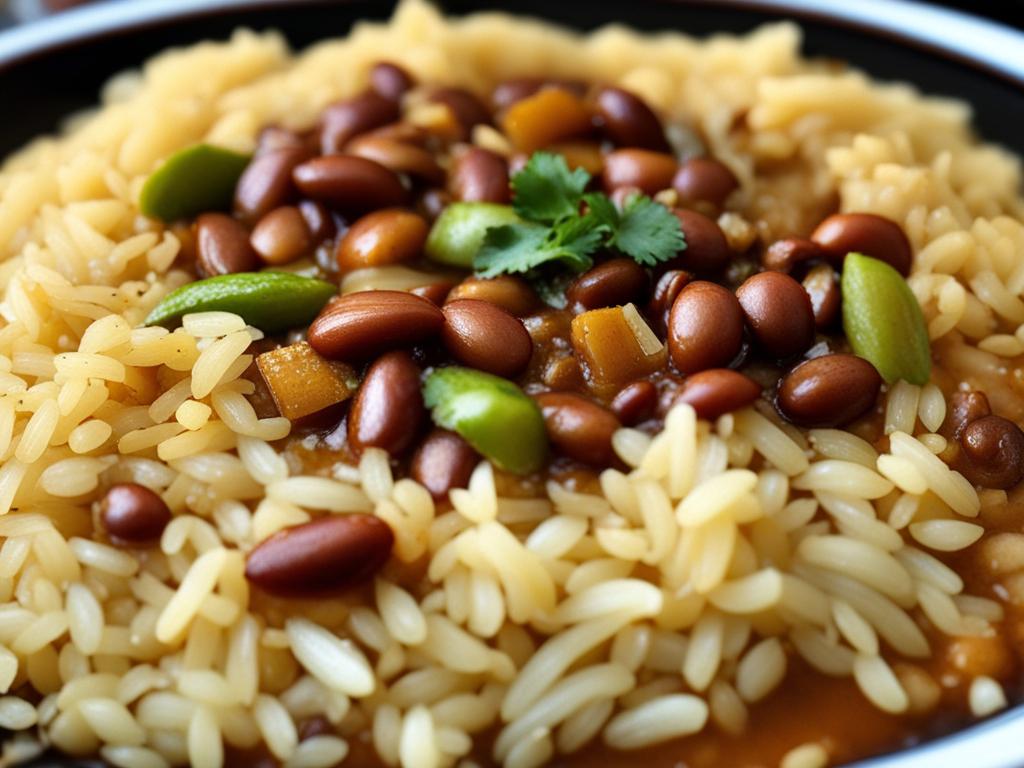
The Key Ingredients of Arroz y Habichuelas
The following table provides an overview of the key ingredients used in arroz y habichuelas:
| Ingredients | Description |
|---|---|
| Pink Beans | Stewed with sofrito, onions, peppers, garlic, and ham hock to create a flavorful base for the dish. |
| Sofrito | A traditional cooking base made from a blend of onion, garlic, peppers, culantro, cilantro, and other herbs and spices. |
| Calabaza Squash | Added to the beans for a hint of sweetness and added depth of flavor. |
| Rice | Cooked separately and served alongside the beans to provide a fluffy and satisfying starch component. |
Arroz y habichuelas is a quintessential Puerto Rican side dish that embodies the flavors and traditions of the island’s cuisine. Whether enjoyed as a comforting home-cooked meal or a flavorful accompaniment at a Puerto Rican restaurant, this classic dish is sure to delight your taste buds and transport you to the vibrant flavors of Puerto Rico.
Tembleque and Coquito: Puerto Rican Desserts and Drinks
When it comes to indulging in the sweet side of Puerto Rican cuisine, two desserts and a classic drink take center stage – Tembleque, Coquito, and a variety of delectable options. These flavorful treats offer a delightful end to any meal, showcasing the rich and vibrant flavors of Puerto Rico.
Tembleque is a silky coconut custard dessert that is as pleasing to the eyes as it is to the palate. Made with coconut milk, sugar, cornstarch, and fragrant spices such as cinnamon and vanilla, tembleque has a smooth and creamy texture that melts in your mouth. Its name, which translates to “wobbly” in English, refers to the delicate and jiggly consistency that is achieved through careful cooking and cooling. Often garnished with a sprinkle of cinnamon on top, tembleque is a refreshing and satisfying dessert that showcases the tropical flavors of Puerto Rico.
Coquito is a beloved Puerto Rican drink that is often enjoyed during the holiday season. This creamy and spiced coconut eggnog is made with a combination of coconut milk, evaporated milk, condensed milk, cinnamon, and a splash of white rum for a touch of warmth and indulgence. Served chilled and garnished with a sprinkle of ground cinnamon or a cinnamon stick, coquito offers a festive twist to a classic drink and is the perfect accompaniment to celebrate special occasions with family and friends.
In addition to tembleque and coquito, Puerto Rico boasts a wide variety of other delightful desserts and sweets. These include arroz con dulce, a rice pudding flavored with cinnamon and raisins; flan, a smooth and creamy vanilla custard cake; and casquitos de guayaba, a delightful combination of guava paste and white cheese. Each of these desserts has its own unique flavors and textures, adding to the diverse culinary tapestry of Puerto Rico.
Table: Puerto Rican Desserts
| Dessert | Description |
|---|---|
| Tembleque | A silky coconut custard dessert with a delicate and jiggly consistency. |
| Coquito | A creamy and spiced coconut eggnog often enjoyed during the holiday season. |
| Arroz con Dulce | A rice pudding flavored with cinnamon and raisins. |
| Flan | A smooth and creamy vanilla custard cake. |
| Casquitos de Guayaba | A sweet treat made from guava paste paired with white cheese. |

“Tembleque, Coquito, and other Puerto Rican desserts are a true celebration of the rich flavors and culinary heritage of the island. Whether you’re savoring the delicate wobble of tembleque or enjoying the festive spirit of coquito, these desserts offer a taste of Puerto Rico’s vibrant culture. Indulge in these sweet delights and experience the joy and warmth that Puerto Rican desserts bring to any occasion.”
From velvety coconut custard to spiced eggnog and an array of other tantalizing options, Puerto Rican desserts are a feast for the senses. These sweets not only showcase the tropical flavors of the island but also embody the rich cultural heritage of Puerto Rico. Whether you’re enjoying a traditional dessert recipe passed down through generations or trying a modern twist on a classic, these sweet treats are sure to leave a lasting impression and a desire for more.
Pasteles: A Traditional Puerto Rican Specialty
Pasteles are a delectable Puerto Rican dish that bears a striking resemblance to tamales. These savory delights are made by combining grated green bananas, yucca, and plantains, which are then filled with seasoned meat and wrapped in a banana leaf. The filled pasteles are then boiled until they reach a mouthwatering perfection, creating a unique and flavorful Puerto Rican side dish.
The process of making pasteles is a labor of love that often involves the participation of family and friends. Each step, from grating the ingredients to wrapping them in banana leaves, is done with care and attention to detail. Traditional fillings for pasteles include pork, chicken, or a combination of both, seasoned with a flavorful blend of spices such as garlic, oregano, and annatto.
The result is a tantalizing combination of flavors and textures that is sure to please any palate. The soft, starchy exterior of the pasteles contrasts beautifully with the savory meat filling, creating a harmonious balance of flavors. Whether enjoyed as a side dish or as a main course, pasteles are a true Puerto Rican delicacy that should not be missed.
| Dish | Description |
|---|---|
| Mofongo | A beloved Puerto Rican dish made from deep-fried green plantain pieces that are mashed with garlic and seasoned with salt-cured pork, pork crackling, butter, or oil. |
| Tostones and Amarillos | Savory fried plantains made from green plantains that are sliced, marinated in water and garlic, fried, smashed, and then fried again until crispy. Amarillos are ripe plantains that are fried until soft and sweet. |
| Lechón Asado | A traditional Puerto Rican dish made from a whole pig that is marinated in adobo and slow-roasted over coals until the meat is juicy and the skin is crispy. Another popular pork dish is pernil, which is seasoned with adobo and roasted in the oven. |
| Arroz y Habichuelas | The staple side dish in Puerto Rico, made by stewing pink beans with onions, peppers, garlic, ham hock, calabaza squash, and sofrito, and serving it alongside cooked rice. |
| Tembleque and Coquito | A silky coconut custard dessert and a Puerto Rican version of eggnog made with coconut milk, evaporated milk, condensed milk, cinnamon, and white rum. |
Pasteles are a beloved part of Puerto Rican cuisine and are often enjoyed during the holiday season or special occasions. The unique combination of ingredients and the time-honored process of making them is a testament to the rich culinary heritage of Puerto Rico. So, if you ever have the opportunity to try these mouthwatering delights, be sure to savor every bite and experience the authentic flavors of Puerto Rican cuisine.
Puerto Rican Asopao: A Hearty Stew-Soup Hybrid
Asopao is a delightful Puerto Rican dish that perfectly combines the comforting flavors of a stew and the heartiness of a soup. This versatile dish is made with white rice and can be prepared with a variety of ingredients, making it suitable for both vegetarian and non-vegetarian preferences. Asopao is a popular side dish in Puerto Rican cuisine and is often enjoyed as a main course as well.
To prepare asopao, start by sautéing onions, peppers, and garlic in a large pot. Then, add your choice of vegetables, such as carrots, peas, or bell peppers, and sauté them until they are slightly tender. Next, add the white rice and stir to coat it with the flavorful mixture. Pour in vegetable or chicken broth and bring the mixture to a boil.
Once the mixture is boiling, reduce the heat to a simmer and cover the pot. Allow the asopao to cook until the rice is tender and has absorbed the flavors of the broth. If you prefer a non-vegetarian version, you can add chicken pieces or seafood, such as shrimp or mussels, to enhance the richness and depth of flavor.
“Asopao is the perfect dish to warm your soul on a cold day. The combination of rice, vegetables, and savory broth creates a comforting and satisfying meal that is sure to please everyone at the table.” – Chef Maria Rodriguez
Asopao is traditionally served hot and garnished with fresh cilantro or parsley. Its hearty and flavorful nature makes it a favorite comfort food among Puerto Ricans. Whether enjoyed as a side dish or a main course, asopao is a true representation of the rich culinary heritage of Puerto Rico.

Asopao Recipe:
| Ingredients | Instructions |
|---|---|
|
|
Enjoy this delicious and comforting Puerto Rican dish as a side or main course, and savor the unique blend of flavors in every spoonful.
Arroz Con Gandules: The National Dish of Puerto Rico
When it comes to Puerto Rican side dishes, one dish stands out as the national favorite: arroz con gandules. This flavorful rice dish is a staple in Puerto Rican cuisine and is often served at festive occasions and family gatherings. Arroz con gandules is a delicious combination of rice, pigeon peas, and sofrito, a traditional cooking base made from onion, garlic, peppers, culantro, cilantro, and other herbs and spices. The dish is cooked together in a flavorful sauce made from annatto, tomato paste, and other seasonings, creating a mouthwatering blend of flavors.
The key ingredient in arroz con gandules is the pigeon peas, which add a unique taste and texture to the dish. Pigeon peas are small, oval-shaped legumes that are slightly nutty in flavor and have a creamy texture when cooked. They are a common ingredient in Caribbean cooking and are widely used in Puerto Rican cuisine. Pigeon peas are not only delicious but also packed with nutrition, providing a good source of protein, fiber, and vitamins.
Arroz con gandules is a versatile side dish that pairs well with a variety of main courses. Whether served alongside roasted pork, grilled chicken, or stewed beef, this flavorful rice dish adds a touch of authenticity to any meal. With its vibrant colors, rich flavors, and cultural significance, arroz con gandules truly represents the essence of Puerto Rican cuisine and is a must-try for anyone looking to experience the flavors of the island.
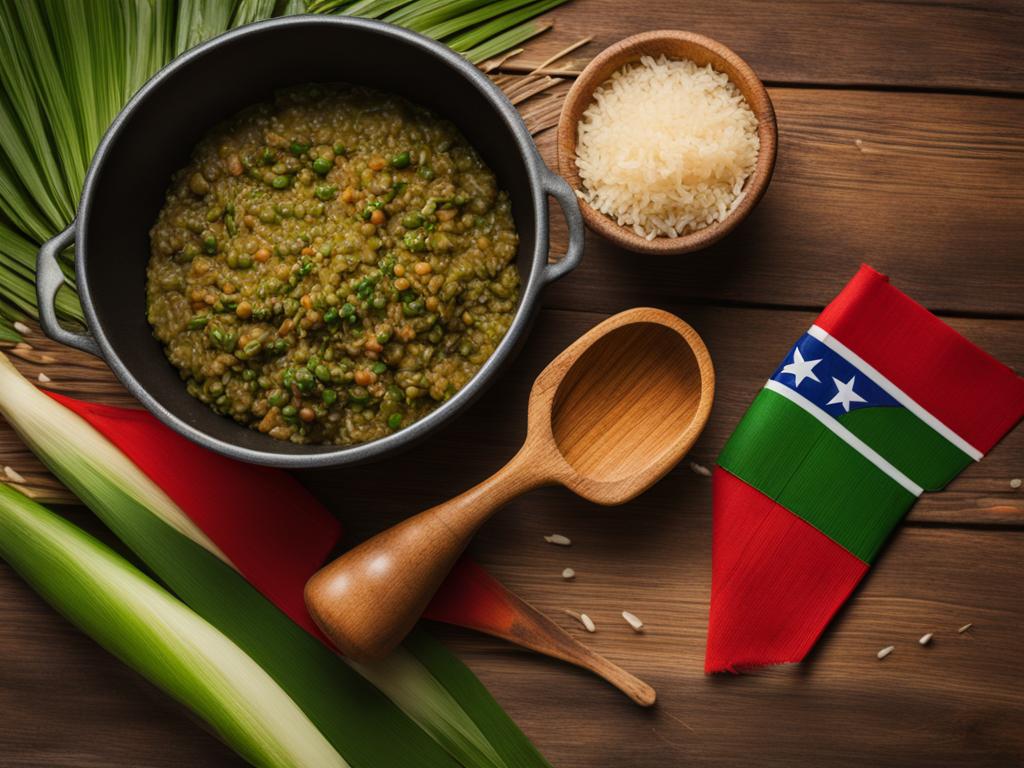
Don’t miss the opportunity to savor the national dish of Puerto Rico – arroz con gandules. With its unique combination of rice, pigeon peas, and sofrito, this flavorful side dish is sure to delight your taste buds and transport you to the beautiful island of Puerto Rico.
Bacalaitos: Crispy Cod Fritters from Puerto Rico
Puerto Rican cuisine is known for its diverse range of flavors and unique dishes. One such dish is bacalaitos, delicious crispy cod fritters that are a popular side dish in Puerto Rico. Made from a batter of flour, water, salted cod, and parsley, these fritters are deep-fried until golden brown, resulting in a crunchy exterior and a tender, flavorful center. Bacalaitos are commonly found in open-air restaurants throughout the island, where locals and tourists alike indulge in their savory goodness. These fritters are often enjoyed with a cold beer, making them the perfect accompaniment to a laid-back island meal.
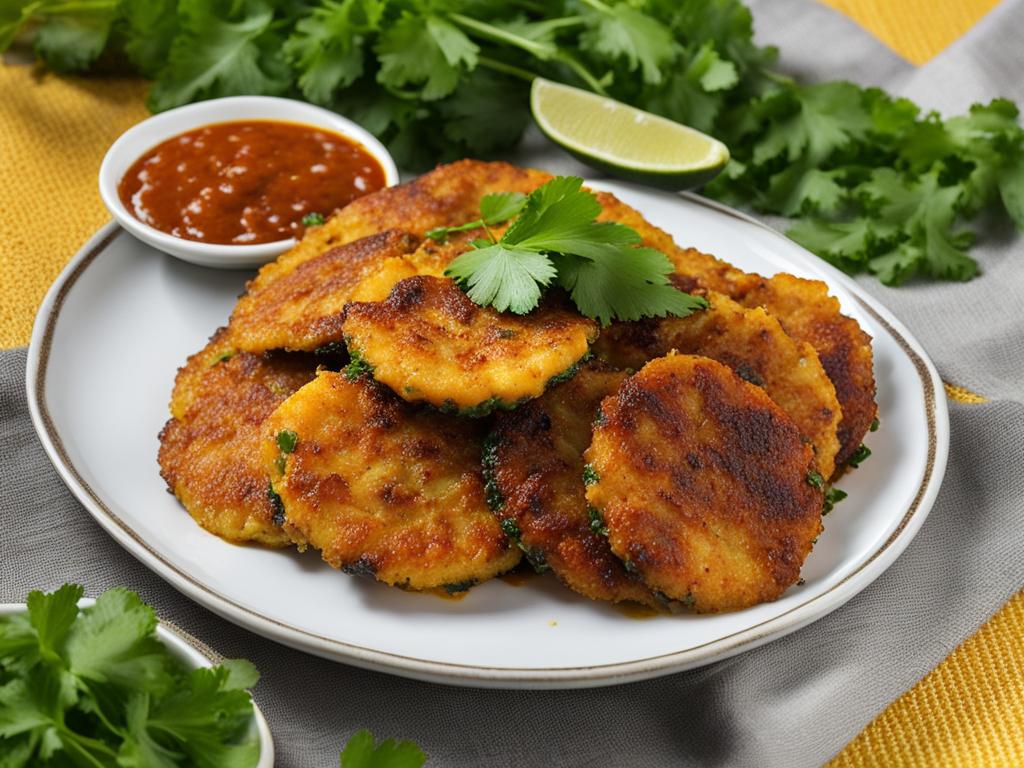
Delicious and Versatile
Bacalaitos not only provide a burst of flavor but also offer versatility in how they can be enjoyed. While they are commonly served as a side dish, they can also be enjoyed as a snack or even as a main course when paired with other dishes. The crispy exterior and savory filling make these fritters a crowd-pleaser at parties and gatherings. Whether you’re hosting a small gathering or simply want to indulge in a tasty treat, bacalaitos are sure to satisfy your cravings.
A Taste of Puerto Rican Cuisine
Bacalaitos are just one example of the rich culinary traditions found in Puerto Rico. The combination of flavors and textures in these fritters showcases the island’s unique blend of influences from African, Spanish, and Indigenous cultures. When visiting Puerto Rico or trying out Puerto Rican recipes at home, don’t miss the opportunity to savor the authentic flavors of bacalaitos and other traditional dishes. They provide a delicious window into the vibrant food culture of the island.
Frituras: Deep-Fried Delights of Puerto Rican Cuisine
In the vibrant culinary landscape of Puerto Rican cuisine, frituras hold a special place as beloved deep-fried treats. These indulgent snacks are commonly found in street food stalls and local eateries across the island, offering a mouthwatering variety of flavors and textures. Two popular examples of frituras are alcapurrias and empanadillas, each with its own unique characteristics and fillings.
Alcapurrias: The Tasty Torpedo-Shaped Fritters
Alcapurrias are torpedo-shaped fritters that are a true delight for the senses. Made from a mixture of grated root vegetables, typically green bananas and yautía (taro root), these fritters are filled with a choice of meat, such as seasoned ground beef or spicy crab. The filling is then enveloped in the flavorful dough, which is deep-fried to crispy perfection. Alcapurrias offer a delightful contrast between the crunchy exterior and the savory filling, making them a popular choice among locals and visitors alike.
Empanadillas: Bite-Sized Flavor Bombs
Empanadillas, on the other hand, are larger versions of the more familiar empanadas. These golden-brown turnovers are filled with a variety of ingredients, including seasoned ground beef, chicken, or cheese. The dough is rolled out and folded over the filling, creating a pocket of deliciousness. Empanadillas are then fried until crispy, resulting in a satisfying combination of flaky crust and flavorful fillings. These bite-sized flavor bombs are a must-try fritura that showcases the versatility of Puerto Rican cuisine.
Whether you choose alcapurrias or empanadillas, indulging in these frituras is an experience that encapsulates the rich culinary heritage of Puerto Rico. The combination of crispy textures, flavorful fillings, and the unique touch of deep-frying creates a truly irresistible treat. So, the next time you find yourself in Puerto Rico, make sure to seek out these deep-fried delights and savor the deliciousness they have to offer.
| Fritura | Description |
|---|---|
| Alcapurrias | Torpedo-shaped fritters made with grated root vegetables and filled with meat or seafood |
| Empanadillas | Larger versions of empanadas, filled with various ingredients such as ground beef or cheese |
Also Read : Discover Delicious Filipino Side Dishes For Your Next Meal!
Conclusion
Exploring Puerto Rican side dishes is a delicious way to immerse yourself in the vibrant flavors and culinary traditions of the island. From iconic dishes like mofongo and arroz con gandules to beloved favorites like tostones and pasteles, Puerto Rican side dishes offer a taste of the island’s rich culture and heritage.
Whether you’re an experienced cook or a beginner in the kitchen, there are plenty of Puerto Rican recipes for side dishes that are easy to make and packed with authentic flavors. Traditional Puerto Rican side dishes are known for their delicious combination of spices and ingredients, resulting in mouthwatering dishes that will satisfy your taste buds.
When it comes to Puerto Rican side dishes, there are popular options that you must-try. These dishes have become staples in Puerto Rican cuisine for a reason—they are simply the best. From the flavorful arroz y habichuelas to the crispy cod fritters known as bacalaitos, these dishes showcase the diverse and delicious flavors that Puerto Rican cuisine has to offer.
Whether you’re cooking at home or dining at a Puerto Rican restaurant, don’t miss the opportunity to savor the authentic flavors and unforgettable dishes that make Puerto Rican cuisine so special. With their bold flavors and unique combinations, Puerto Rican side dishes are sure to delight your taste buds and leave you craving for more.
FAQs
Q: What are some classic Puerto Rican side dishes?
A: Some classic Puerto Rican side dishes include fried plantains, arroz con pollo, pastelón, habichuelas guisadas, and savory rice dishes like rice with pigeon peas.
Q: What is sofrito in Puerto Rican cooking?
A: Sofrito is a flavorful seasoning used in many Puerto Rican recipes, made from ingredients such as onions, peppers, garlic, and herbs, traditionally made by sautéing and blending them together.
Q: How is arroz con pollo prepared in Puerto Rican cuisine?
A: Arroz con pollo, a popular rice dish in Puerto Rican cuisine, is prepared by cooking rice with chicken, onions, peppers, and seasoning, resulting in a savory and satisfying dish.
Q: What is pastelón in Puerto Rican cuisine?
A: Pastelón is a delicious Puerto Rican dish similar to lasagna, made with layers of sweet plantains, savory ground meat, and cheese, creating a delightful and hearty meal.
Q: How are habichuelas guisadas made?
A: Habichuelas guisadas are Puerto Rican-style stewed beans, traditionally made by simmering red beans with spices, tomato sauce, and other flavorful ingredients, resulting in a tasty side dish.
Q: What are some key ingredients used in Puerto Rican side dishes?
A: Key ingredients commonly used in Puerto Rican side dishes include chicken, pigeon peas, olives, bell peppers, garlic, and various spices that contribute to the authentic and savory flavors of the cuisine.
Q: How is asopao de pollo different from other Puerto Rican dishes?
A: Asopao de pollo is a Puerto Rican chicken stew with a unique twist, as it combines the heartiness of a rice dish with the comfort of a stew, making it a popular and comforting option among Puerto Rican recipes.
Q: What is the significance of rice with pigeon peas in Puerto Rican cuisine?
A: Rice with pigeon peas, known as “arroz con gandules,” holds significance in Puerto Rican cuisine as a traditional and beloved rice dish often served during special occasions and family gatherings, symbolizing warmth and togetherness.
Q: How can I make authentic Puerto Rican side dishes at home?
A: To make authentic Puerto Rican side dishes at home, you can explore traditional recipes, use classic seasonings and spices, and embrace the rich flavors and techniques of Puerto Rican cooking to create satisfying and flavorful dishes in your kitchen.
Q: What are some quick and easy Puerto Rican side dish recipes?
A: Some quick and easy Puerto Rican side dish recipes include making flavorful fried plantains, whipping up a hearty and comforting chicken stew, and preparing savory rice dishes with pigeon peas for a delicious addition to any meal.
Source Links
- https://www.discoverpuertorico.com/article/food-trails-culinary-adventures-puerto-rico
- https://www.discoverpuertorico.com/article/guide-to-traditional-puerto-rican-food
- https://theplanetd.com/puerto-rican-food/








Leave A Comment